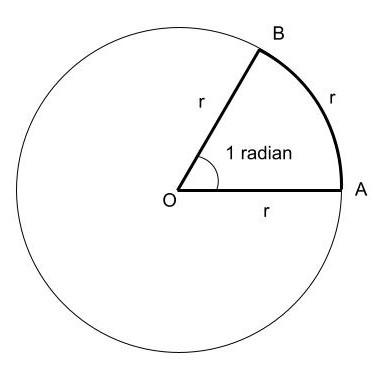
How do you convert 40 degrees into radians?
Answer
543k+ views
Hint: Radian is one of the units for measuring the angles. One radian is equal to the angle formed by an arc having a length equal to the radius of the circle. The circumference of a circle is $2\pi r$. Therefore one complete rotation will be equal to $2\pi $ radians.
Complete Step by Step Solution:
To understand how radian is measured, let us consider a circle of radius r.

The angle made by an arc having a length equal to the radius of the circle is equal to one radius. We know that the circumference of a circle is
$\Rightarrow P=\pi d=2\pi r$
Where $\pi $ is a mathematical constant which is approximately equal to the value $\dfrac{22}{7}$ and d is the diameter of the circle.
One complete rotation will form an angle equal to ${{360}^{\circ }}$. Therefore the angle formed by the circumference of the circle is equal to ${{360}^{\circ }}$.
The angle formed by an arc length equal to the radius ( r ) is equal to 1 radian.
Hence the angle formed by the circumference ($2\pi r$) is equal to $2\pi $radians and is equal to ${{360}^{\circ }}$.
$\Rightarrow 2\pi \text{ rad}={{360}^{\circ }}$ ……(1)
Now we have our conversion factor.
The given problem is that we have to convert the angle 40 degrees into radians. We already know that
$\Rightarrow 2\pi \text{ rad}={{360}^{\circ }}$
We can rewrite the above equation as
$\Rightarrow \dfrac{2\pi }{360}\text{ rad}={{1}^{\circ }}$ ……(2)
Hence an angle of one degree is equal to $\dfrac{2\pi }{360}$ radians. Equation (2) provides the conversion factor.
We have to convert the angle 40 degrees into radians. Hence from equation (2)
$\Rightarrow {{40}^{\circ }}=\dfrac{2\pi }{360}\times \text{40 rad}$
Now substitute the value of the mathematical constant pi ($\pi =3.143$)
$\Rightarrow {{40}^{\circ }}=\dfrac{2\times 3.143}{360}\times \text{40 rad}$
$\Rightarrow {{40}^{\circ }}=\dfrac{251.44}{360}\text{ rad}=0.698\text{4 radians}$
Therefore the angle of 40 degrees is equivalent to 0.6984 radians.
Note:
When converting from radian to degrees, we should not mention the degrees in decimal quantity. We should denote the decimal angle part using minutes and seconds.
For example, consider a situation in which we have to convert 0.7 radians into degrees. From equation (1) we have
$\Rightarrow 1\text{ rad}=\dfrac{360}{2\pi }\text{degrees}$
For 0.7 radians
$\Rightarrow \text{0}\text{.7 rad}=0.7\times \dfrac{360}{2\pi }\text{degrees}$
$\Rightarrow \text{0}\text{.7 rad}=40.\text{107 degrees}$
Instead of writing 40.107 degrees, we should denote it as follows
$\Rightarrow {{1}^{\circ }}=6{0}'$ (minute of arc)
$\Rightarrow 0.107rad=0.107\times 6{0}'=6.4{2}'$
Similarly
$\Rightarrow {1}'=6{0}''$ (second of arc)
$\Rightarrow 0.4{2}'=0.42\times 6{0}''=2{5}''$
Therefore the angle is $\text{4}{{\text{0}}^{\circ }}\text{ {6}' 2{5}''}$and not ${{40.107}^{\circ }}$.
Complete Step by Step Solution:
To understand how radian is measured, let us consider a circle of radius r.

The angle made by an arc having a length equal to the radius of the circle is equal to one radius. We know that the circumference of a circle is
$\Rightarrow P=\pi d=2\pi r$
Where $\pi $ is a mathematical constant which is approximately equal to the value $\dfrac{22}{7}$ and d is the diameter of the circle.
One complete rotation will form an angle equal to ${{360}^{\circ }}$. Therefore the angle formed by the circumference of the circle is equal to ${{360}^{\circ }}$.
The angle formed by an arc length equal to the radius ( r ) is equal to 1 radian.
Hence the angle formed by the circumference ($2\pi r$) is equal to $2\pi $radians and is equal to ${{360}^{\circ }}$.
$\Rightarrow 2\pi \text{ rad}={{360}^{\circ }}$ ……(1)
Now we have our conversion factor.
The given problem is that we have to convert the angle 40 degrees into radians. We already know that
$\Rightarrow 2\pi \text{ rad}={{360}^{\circ }}$
We can rewrite the above equation as
$\Rightarrow \dfrac{2\pi }{360}\text{ rad}={{1}^{\circ }}$ ……(2)
Hence an angle of one degree is equal to $\dfrac{2\pi }{360}$ radians. Equation (2) provides the conversion factor.
We have to convert the angle 40 degrees into radians. Hence from equation (2)
$\Rightarrow {{40}^{\circ }}=\dfrac{2\pi }{360}\times \text{40 rad}$
Now substitute the value of the mathematical constant pi ($\pi =3.143$)
$\Rightarrow {{40}^{\circ }}=\dfrac{2\times 3.143}{360}\times \text{40 rad}$
$\Rightarrow {{40}^{\circ }}=\dfrac{251.44}{360}\text{ rad}=0.698\text{4 radians}$
Therefore the angle of 40 degrees is equivalent to 0.6984 radians.
Note:
When converting from radian to degrees, we should not mention the degrees in decimal quantity. We should denote the decimal angle part using minutes and seconds.
For example, consider a situation in which we have to convert 0.7 radians into degrees. From equation (1) we have
$\Rightarrow 1\text{ rad}=\dfrac{360}{2\pi }\text{degrees}$
For 0.7 radians
$\Rightarrow \text{0}\text{.7 rad}=0.7\times \dfrac{360}{2\pi }\text{degrees}$
$\Rightarrow \text{0}\text{.7 rad}=40.\text{107 degrees}$
Instead of writing 40.107 degrees, we should denote it as follows
$\Rightarrow {{1}^{\circ }}=6{0}'$ (minute of arc)
$\Rightarrow 0.107rad=0.107\times 6{0}'=6.4{2}'$
Similarly
$\Rightarrow {1}'=6{0}''$ (second of arc)
$\Rightarrow 0.4{2}'=0.42\times 6{0}''=2{5}''$
Therefore the angle is $\text{4}{{\text{0}}^{\circ }}\text{ {6}' 2{5}''}$and not ${{40.107}^{\circ }}$.
Recently Updated Pages
You are awaiting your class 10th results Meanwhile class 7 english CBSE

Master Class 7 Social Science: Engaging Questions & Answers for Success

Master Class 7 Science: Engaging Questions & Answers for Success

Class 7 Question and Answer - Your Ultimate Solutions Guide

Master Class 7 English: Engaging Questions & Answers for Success

Master Class 7 Maths: Engaging Questions & Answers for Success

Trending doubts
Convert 200 Million dollars in rupees class 7 maths CBSE

Full Form of IASDMIPSIFSIRSPOLICE class 7 social science CBSE

i What trees does Mr Wonka mention Which tree does class 7 english CBSE

What are the controls affecting the climate of Ind class 7 social science CBSE

What was the main occupation of early Aryans of rig class 7 social science CBSE

Write a letter to the editor of the national daily class 7 english CBSE





